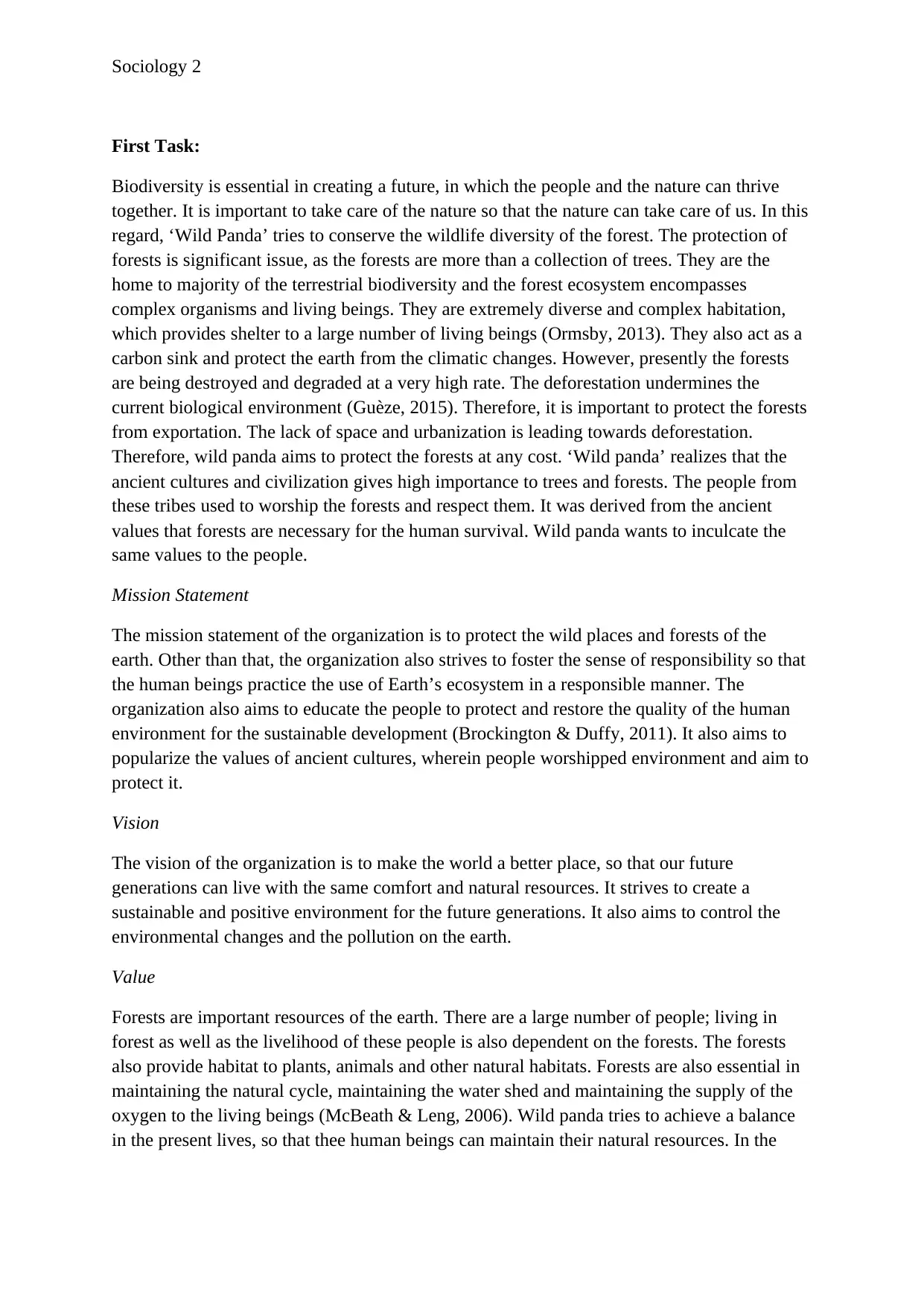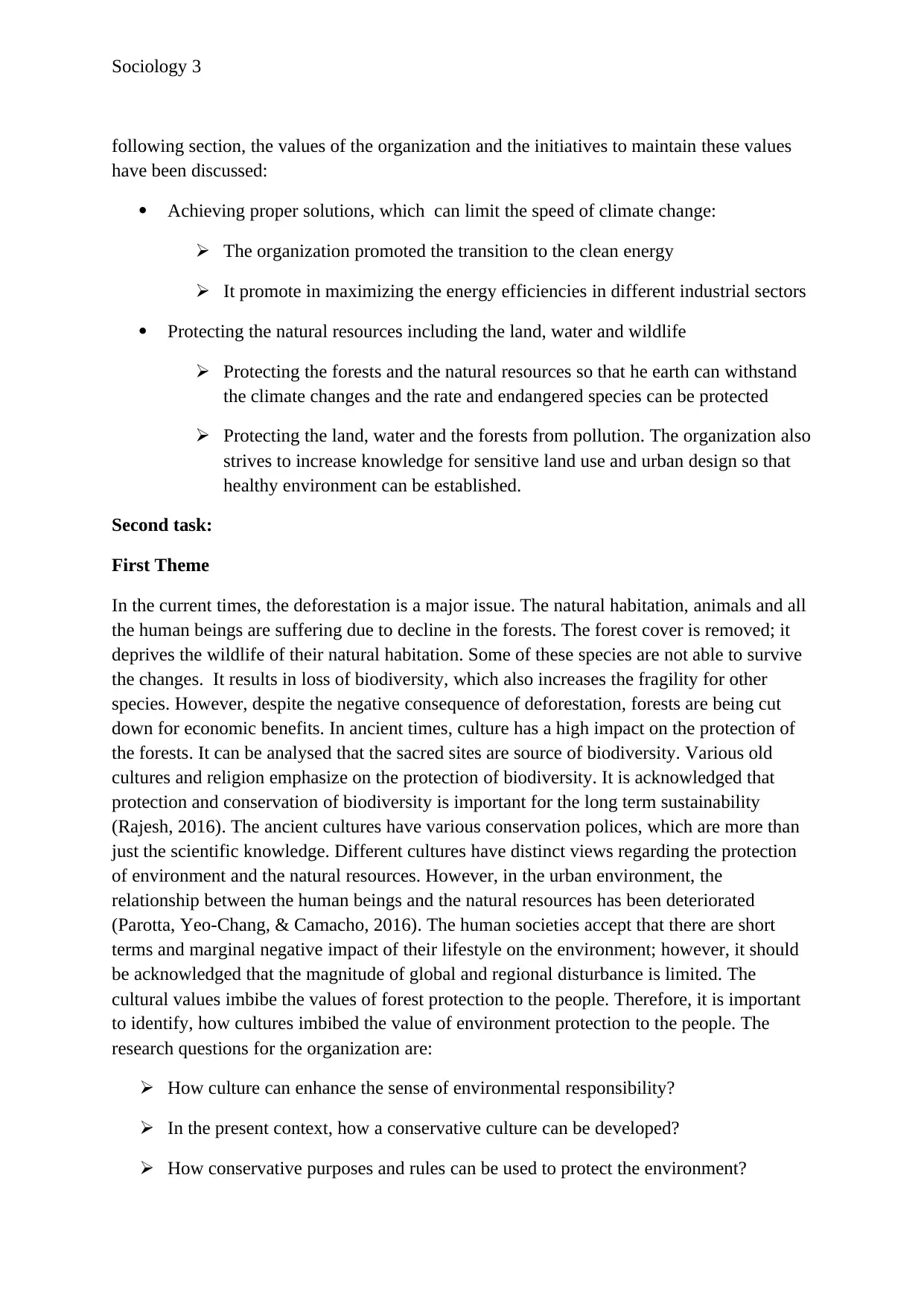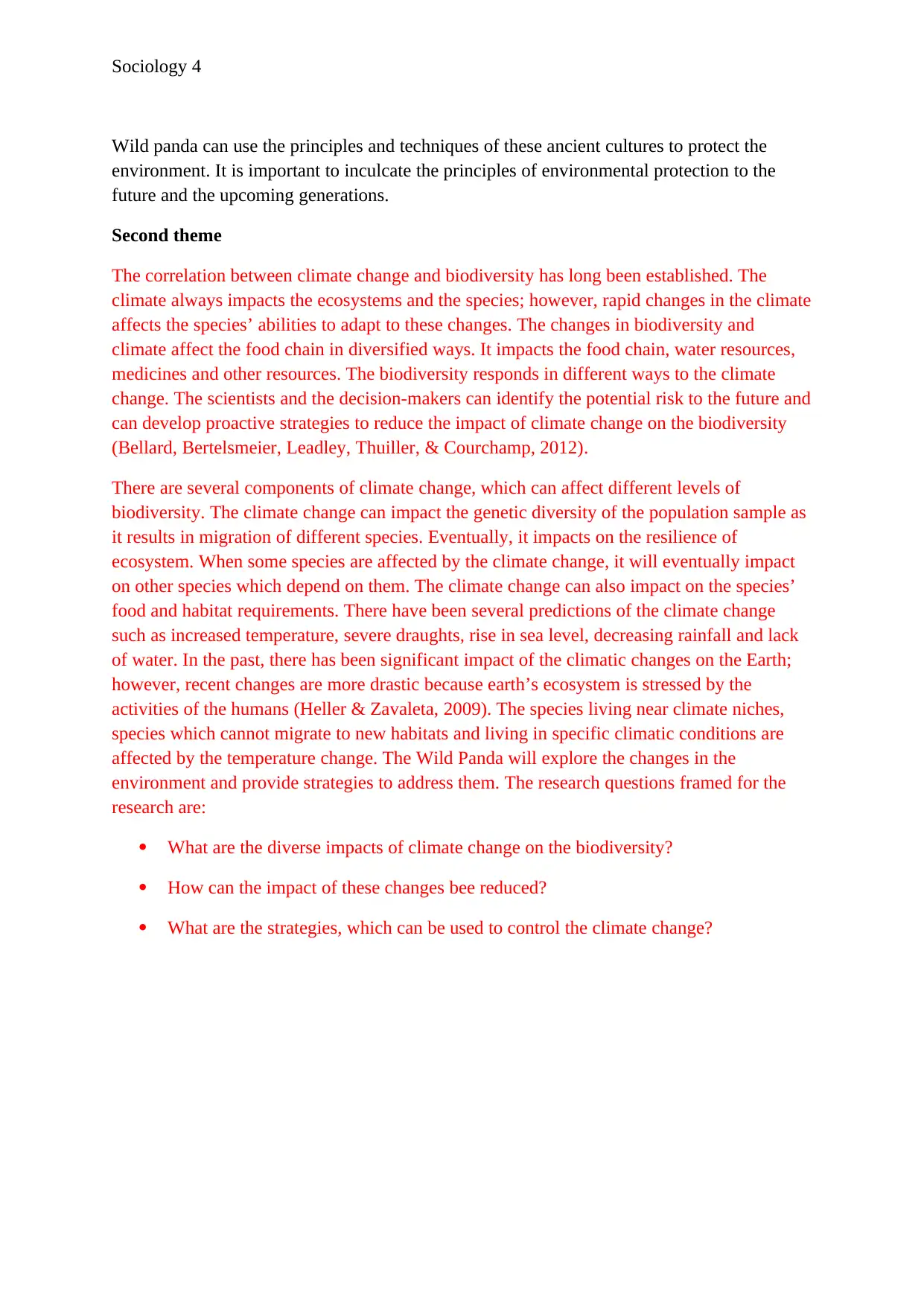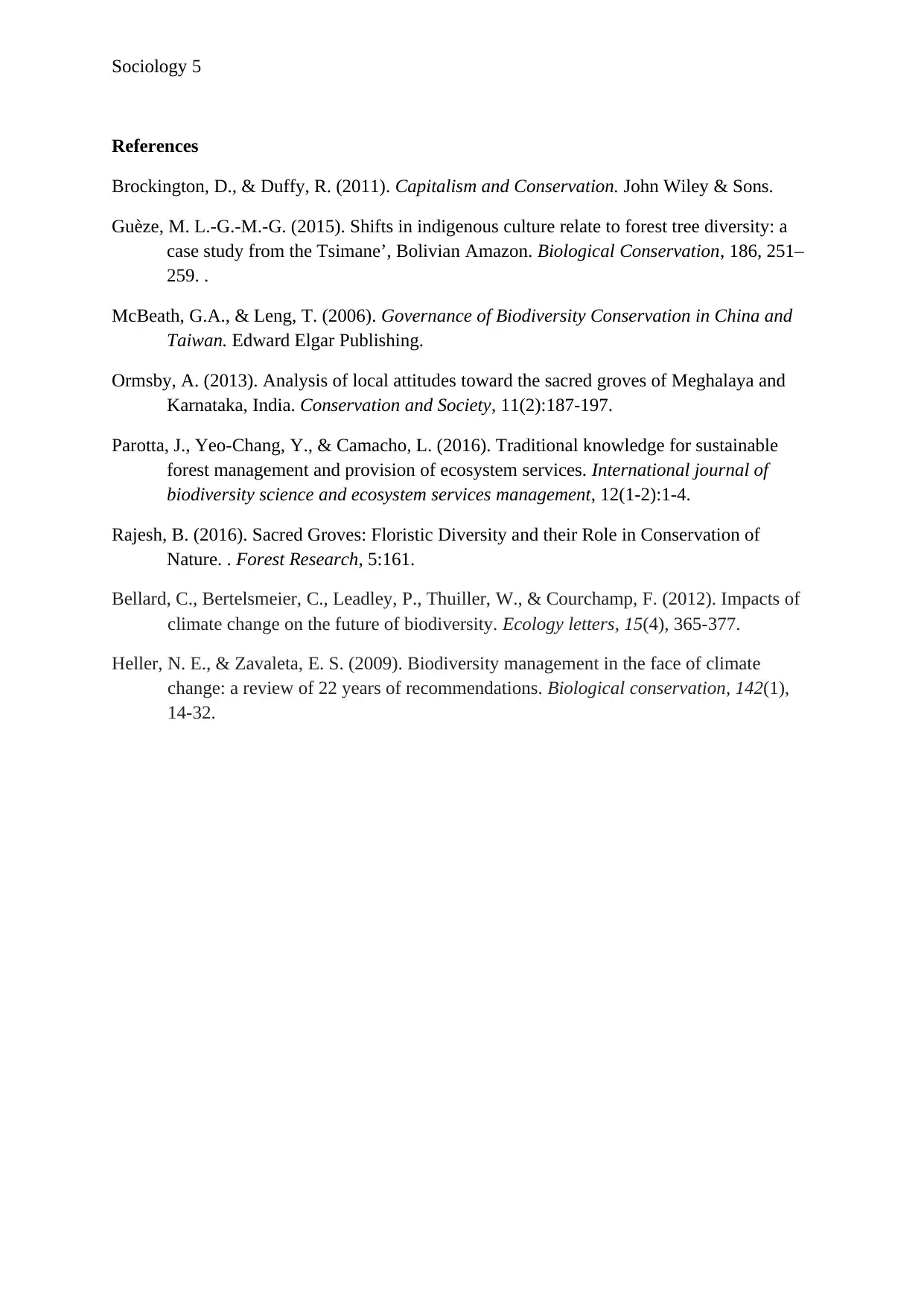Sociology Report: Wild Panda's Strategies for Biodiversity and Culture
VerifiedAdded on 2023/06/13
|5
|1699
|171
Report
AI Summary
This report analyzes Wild Panda's mission to protect wild places and foster environmental responsibility through a sociological lens. It highlights the organization's mission, vision, and values, focusing on limiting climate change and protecting natural resources. The report emphasizes the importance of integrating ancient cultural values of forest worship into modern conservation efforts. It explores the correlation between climate change and biodiversity, posing research questions about enhancing environmental responsibility through culture and mitigating the impacts of climate change on biodiversity. The document further investigates how cultural values imbibe the values of forest protection to the people and how conservative purposes and rules can be used to protect the environment. It also explores the changes in the environment and provides strategies to address them.

Running Head: Sociology 1
Sociology
Sociology
Paraphrase This Document
Need a fresh take? Get an instant paraphrase of this document with our AI Paraphraser

Sociology 2
First Task:
Biodiversity is essential in creating a future, in which the people and the nature can thrive
together. It is important to take care of the nature so that the nature can take care of us. In this
regard, ‘Wild Panda’ tries to conserve the wildlife diversity of the forest. The protection of
forests is significant issue, as the forests are more than a collection of trees. They are the
home to majority of the terrestrial biodiversity and the forest ecosystem encompasses
complex organisms and living beings. They are extremely diverse and complex habitation,
which provides shelter to a large number of living beings (Ormsby, 2013). They also act as a
carbon sink and protect the earth from the climatic changes. However, presently the forests
are being destroyed and degraded at a very high rate. The deforestation undermines the
current biological environment (Guèze, 2015). Therefore, it is important to protect the forests
from exportation. The lack of space and urbanization is leading towards deforestation.
Therefore, wild panda aims to protect the forests at any cost. ‘Wild panda’ realizes that the
ancient cultures and civilization gives high importance to trees and forests. The people from
these tribes used to worship the forests and respect them. It was derived from the ancient
values that forests are necessary for the human survival. Wild panda wants to inculcate the
same values to the people.
Mission Statement
The mission statement of the organization is to protect the wild places and forests of the
earth. Other than that, the organization also strives to foster the sense of responsibility so that
the human beings practice the use of Earth’s ecosystem in a responsible manner. The
organization also aims to educate the people to protect and restore the quality of the human
environment for the sustainable development (Brockington & Duffy, 2011). It also aims to
popularize the values of ancient cultures, wherein people worshipped environment and aim to
protect it.
Vision
The vision of the organization is to make the world a better place, so that our future
generations can live with the same comfort and natural resources. It strives to create a
sustainable and positive environment for the future generations. It also aims to control the
environmental changes and the pollution on the earth.
Value
Forests are important resources of the earth. There are a large number of people; living in
forest as well as the livelihood of these people is also dependent on the forests. The forests
also provide habitat to plants, animals and other natural habitats. Forests are also essential in
maintaining the natural cycle, maintaining the water shed and maintaining the supply of the
oxygen to the living beings (McBeath & Leng, 2006). Wild panda tries to achieve a balance
in the present lives, so that thee human beings can maintain their natural resources. In the
First Task:
Biodiversity is essential in creating a future, in which the people and the nature can thrive
together. It is important to take care of the nature so that the nature can take care of us. In this
regard, ‘Wild Panda’ tries to conserve the wildlife diversity of the forest. The protection of
forests is significant issue, as the forests are more than a collection of trees. They are the
home to majority of the terrestrial biodiversity and the forest ecosystem encompasses
complex organisms and living beings. They are extremely diverse and complex habitation,
which provides shelter to a large number of living beings (Ormsby, 2013). They also act as a
carbon sink and protect the earth from the climatic changes. However, presently the forests
are being destroyed and degraded at a very high rate. The deforestation undermines the
current biological environment (Guèze, 2015). Therefore, it is important to protect the forests
from exportation. The lack of space and urbanization is leading towards deforestation.
Therefore, wild panda aims to protect the forests at any cost. ‘Wild panda’ realizes that the
ancient cultures and civilization gives high importance to trees and forests. The people from
these tribes used to worship the forests and respect them. It was derived from the ancient
values that forests are necessary for the human survival. Wild panda wants to inculcate the
same values to the people.
Mission Statement
The mission statement of the organization is to protect the wild places and forests of the
earth. Other than that, the organization also strives to foster the sense of responsibility so that
the human beings practice the use of Earth’s ecosystem in a responsible manner. The
organization also aims to educate the people to protect and restore the quality of the human
environment for the sustainable development (Brockington & Duffy, 2011). It also aims to
popularize the values of ancient cultures, wherein people worshipped environment and aim to
protect it.
Vision
The vision of the organization is to make the world a better place, so that our future
generations can live with the same comfort and natural resources. It strives to create a
sustainable and positive environment for the future generations. It also aims to control the
environmental changes and the pollution on the earth.
Value
Forests are important resources of the earth. There are a large number of people; living in
forest as well as the livelihood of these people is also dependent on the forests. The forests
also provide habitat to plants, animals and other natural habitats. Forests are also essential in
maintaining the natural cycle, maintaining the water shed and maintaining the supply of the
oxygen to the living beings (McBeath & Leng, 2006). Wild panda tries to achieve a balance
in the present lives, so that thee human beings can maintain their natural resources. In the

Sociology 3
following section, the values of the organization and the initiatives to maintain these values
have been discussed:
Achieving proper solutions, which can limit the speed of climate change:
The organization promoted the transition to the clean energy
It promote in maximizing the energy efficiencies in different industrial sectors
Protecting the natural resources including the land, water and wildlife
Protecting the forests and the natural resources so that he earth can withstand
the climate changes and the rate and endangered species can be protected
Protecting the land, water and the forests from pollution. The organization also
strives to increase knowledge for sensitive land use and urban design so that
healthy environment can be established.
Second task:
First Theme
In the current times, the deforestation is a major issue. The natural habitation, animals and all
the human beings are suffering due to decline in the forests. The forest cover is removed; it
deprives the wildlife of their natural habitation. Some of these species are not able to survive
the changes. It results in loss of biodiversity, which also increases the fragility for other
species. However, despite the negative consequence of deforestation, forests are being cut
down for economic benefits. In ancient times, culture has a high impact on the protection of
the forests. It can be analysed that the sacred sites are source of biodiversity. Various old
cultures and religion emphasize on the protection of biodiversity. It is acknowledged that
protection and conservation of biodiversity is important for the long term sustainability
(Rajesh, 2016). The ancient cultures have various conservation polices, which are more than
just the scientific knowledge. Different cultures have distinct views regarding the protection
of environment and the natural resources. However, in the urban environment, the
relationship between the human beings and the natural resources has been deteriorated
(Parotta, Yeo-Chang, & Camacho, 2016). The human societies accept that there are short
terms and marginal negative impact of their lifestyle on the environment; however, it should
be acknowledged that the magnitude of global and regional disturbance is limited. The
cultural values imbibe the values of forest protection to the people. Therefore, it is important
to identify, how cultures imbibed the value of environment protection to the people. The
research questions for the organization are:
How culture can enhance the sense of environmental responsibility?
In the present context, how a conservative culture can be developed?
How conservative purposes and rules can be used to protect the environment?
following section, the values of the organization and the initiatives to maintain these values
have been discussed:
Achieving proper solutions, which can limit the speed of climate change:
The organization promoted the transition to the clean energy
It promote in maximizing the energy efficiencies in different industrial sectors
Protecting the natural resources including the land, water and wildlife
Protecting the forests and the natural resources so that he earth can withstand
the climate changes and the rate and endangered species can be protected
Protecting the land, water and the forests from pollution. The organization also
strives to increase knowledge for sensitive land use and urban design so that
healthy environment can be established.
Second task:
First Theme
In the current times, the deforestation is a major issue. The natural habitation, animals and all
the human beings are suffering due to decline in the forests. The forest cover is removed; it
deprives the wildlife of their natural habitation. Some of these species are not able to survive
the changes. It results in loss of biodiversity, which also increases the fragility for other
species. However, despite the negative consequence of deforestation, forests are being cut
down for economic benefits. In ancient times, culture has a high impact on the protection of
the forests. It can be analysed that the sacred sites are source of biodiversity. Various old
cultures and religion emphasize on the protection of biodiversity. It is acknowledged that
protection and conservation of biodiversity is important for the long term sustainability
(Rajesh, 2016). The ancient cultures have various conservation polices, which are more than
just the scientific knowledge. Different cultures have distinct views regarding the protection
of environment and the natural resources. However, in the urban environment, the
relationship between the human beings and the natural resources has been deteriorated
(Parotta, Yeo-Chang, & Camacho, 2016). The human societies accept that there are short
terms and marginal negative impact of their lifestyle on the environment; however, it should
be acknowledged that the magnitude of global and regional disturbance is limited. The
cultural values imbibe the values of forest protection to the people. Therefore, it is important
to identify, how cultures imbibed the value of environment protection to the people. The
research questions for the organization are:
How culture can enhance the sense of environmental responsibility?
In the present context, how a conservative culture can be developed?
How conservative purposes and rules can be used to protect the environment?
⊘ This is a preview!⊘
Do you want full access?
Subscribe today to unlock all pages.

Trusted by 1+ million students worldwide

Sociology 4
Wild panda can use the principles and techniques of these ancient cultures to protect the
environment. It is important to inculcate the principles of environmental protection to the
future and the upcoming generations.
Second theme
The correlation between climate change and biodiversity has long been established. The
climate always impacts the ecosystems and the species; however, rapid changes in the climate
affects the species’ abilities to adapt to these changes. The changes in biodiversity and
climate affect the food chain in diversified ways. It impacts the food chain, water resources,
medicines and other resources. The biodiversity responds in different ways to the climate
change. The scientists and the decision-makers can identify the potential risk to the future and
can develop proactive strategies to reduce the impact of climate change on the biodiversity
(Bellard, Bertelsmeier, Leadley, Thuiller, & Courchamp, 2012).
There are several components of climate change, which can affect different levels of
biodiversity. The climate change can impact the genetic diversity of the population sample as
it results in migration of different species. Eventually, it impacts on the resilience of
ecosystem. When some species are affected by the climate change, it will eventually impact
on other species which depend on them. The climate change can also impact on the species’
food and habitat requirements. There have been several predictions of the climate change
such as increased temperature, severe draughts, rise in sea level, decreasing rainfall and lack
of water. In the past, there has been significant impact of the climatic changes on the Earth;
however, recent changes are more drastic because earth’s ecosystem is stressed by the
activities of the humans (Heller & Zavaleta, 2009). The species living near climate niches,
species which cannot migrate to new habitats and living in specific climatic conditions are
affected by the temperature change. The Wild Panda will explore the changes in the
environment and provide strategies to address them. The research questions framed for the
research are:
What are the diverse impacts of climate change on the biodiversity?
How can the impact of these changes bee reduced?
What are the strategies, which can be used to control the climate change?
Wild panda can use the principles and techniques of these ancient cultures to protect the
environment. It is important to inculcate the principles of environmental protection to the
future and the upcoming generations.
Second theme
The correlation between climate change and biodiversity has long been established. The
climate always impacts the ecosystems and the species; however, rapid changes in the climate
affects the species’ abilities to adapt to these changes. The changes in biodiversity and
climate affect the food chain in diversified ways. It impacts the food chain, water resources,
medicines and other resources. The biodiversity responds in different ways to the climate
change. The scientists and the decision-makers can identify the potential risk to the future and
can develop proactive strategies to reduce the impact of climate change on the biodiversity
(Bellard, Bertelsmeier, Leadley, Thuiller, & Courchamp, 2012).
There are several components of climate change, which can affect different levels of
biodiversity. The climate change can impact the genetic diversity of the population sample as
it results in migration of different species. Eventually, it impacts on the resilience of
ecosystem. When some species are affected by the climate change, it will eventually impact
on other species which depend on them. The climate change can also impact on the species’
food and habitat requirements. There have been several predictions of the climate change
such as increased temperature, severe draughts, rise in sea level, decreasing rainfall and lack
of water. In the past, there has been significant impact of the climatic changes on the Earth;
however, recent changes are more drastic because earth’s ecosystem is stressed by the
activities of the humans (Heller & Zavaleta, 2009). The species living near climate niches,
species which cannot migrate to new habitats and living in specific climatic conditions are
affected by the temperature change. The Wild Panda will explore the changes in the
environment and provide strategies to address them. The research questions framed for the
research are:
What are the diverse impacts of climate change on the biodiversity?
How can the impact of these changes bee reduced?
What are the strategies, which can be used to control the climate change?
Paraphrase This Document
Need a fresh take? Get an instant paraphrase of this document with our AI Paraphraser

Sociology 5
References
Brockington, D., & Duffy, R. (2011). Capitalism and Conservation. John Wiley & Sons.
Guèze, M. L.-G.-M.-G. (2015). Shifts in indigenous culture relate to forest tree diversity: a
case study from the Tsimane’, Bolivian Amazon. Biological Conservation, 186, 251–
259. .
McBeath, G.A., & Leng, T. (2006). Governance of Biodiversity Conservation in China and
Taiwan. Edward Elgar Publishing.
Ormsby, A. (2013). Analysis of local attitudes toward the sacred groves of Meghalaya and
Karnataka, India. Conservation and Society, 11(2):187-197.
Parotta, J., Yeo-Chang, Y., & Camacho, L. (2016). Traditional knowledge for sustainable
forest management and provision of ecosystem services. International journal of
biodiversity science and ecosystem services management, 12(1-2):1-4.
Rajesh, B. (2016). Sacred Groves: Floristic Diversity and their Role in Conservation of
Nature. . Forest Research, 5:161.
Bellard, C., Bertelsmeier, C., Leadley, P., Thuiller, W., & Courchamp, F. (2012). Impacts of
climate change on the future of biodiversity. Ecology letters, 15(4), 365-377.
Heller, N. E., & Zavaleta, E. S. (2009). Biodiversity management in the face of climate
change: a review of 22 years of recommendations. Biological conservation, 142(1),
14-32.
References
Brockington, D., & Duffy, R. (2011). Capitalism and Conservation. John Wiley & Sons.
Guèze, M. L.-G.-M.-G. (2015). Shifts in indigenous culture relate to forest tree diversity: a
case study from the Tsimane’, Bolivian Amazon. Biological Conservation, 186, 251–
259. .
McBeath, G.A., & Leng, T. (2006). Governance of Biodiversity Conservation in China and
Taiwan. Edward Elgar Publishing.
Ormsby, A. (2013). Analysis of local attitudes toward the sacred groves of Meghalaya and
Karnataka, India. Conservation and Society, 11(2):187-197.
Parotta, J., Yeo-Chang, Y., & Camacho, L. (2016). Traditional knowledge for sustainable
forest management and provision of ecosystem services. International journal of
biodiversity science and ecosystem services management, 12(1-2):1-4.
Rajesh, B. (2016). Sacred Groves: Floristic Diversity and their Role in Conservation of
Nature. . Forest Research, 5:161.
Bellard, C., Bertelsmeier, C., Leadley, P., Thuiller, W., & Courchamp, F. (2012). Impacts of
climate change on the future of biodiversity. Ecology letters, 15(4), 365-377.
Heller, N. E., & Zavaleta, E. S. (2009). Biodiversity management in the face of climate
change: a review of 22 years of recommendations. Biological conservation, 142(1),
14-32.
1 out of 5
Related Documents
Your All-in-One AI-Powered Toolkit for Academic Success.
+13062052269
info@desklib.com
Available 24*7 on WhatsApp / Email
![[object Object]](/_next/static/media/star-bottom.7253800d.svg)
Unlock your academic potential
Copyright © 2020–2025 A2Z Services. All Rights Reserved. Developed and managed by ZUCOL.





